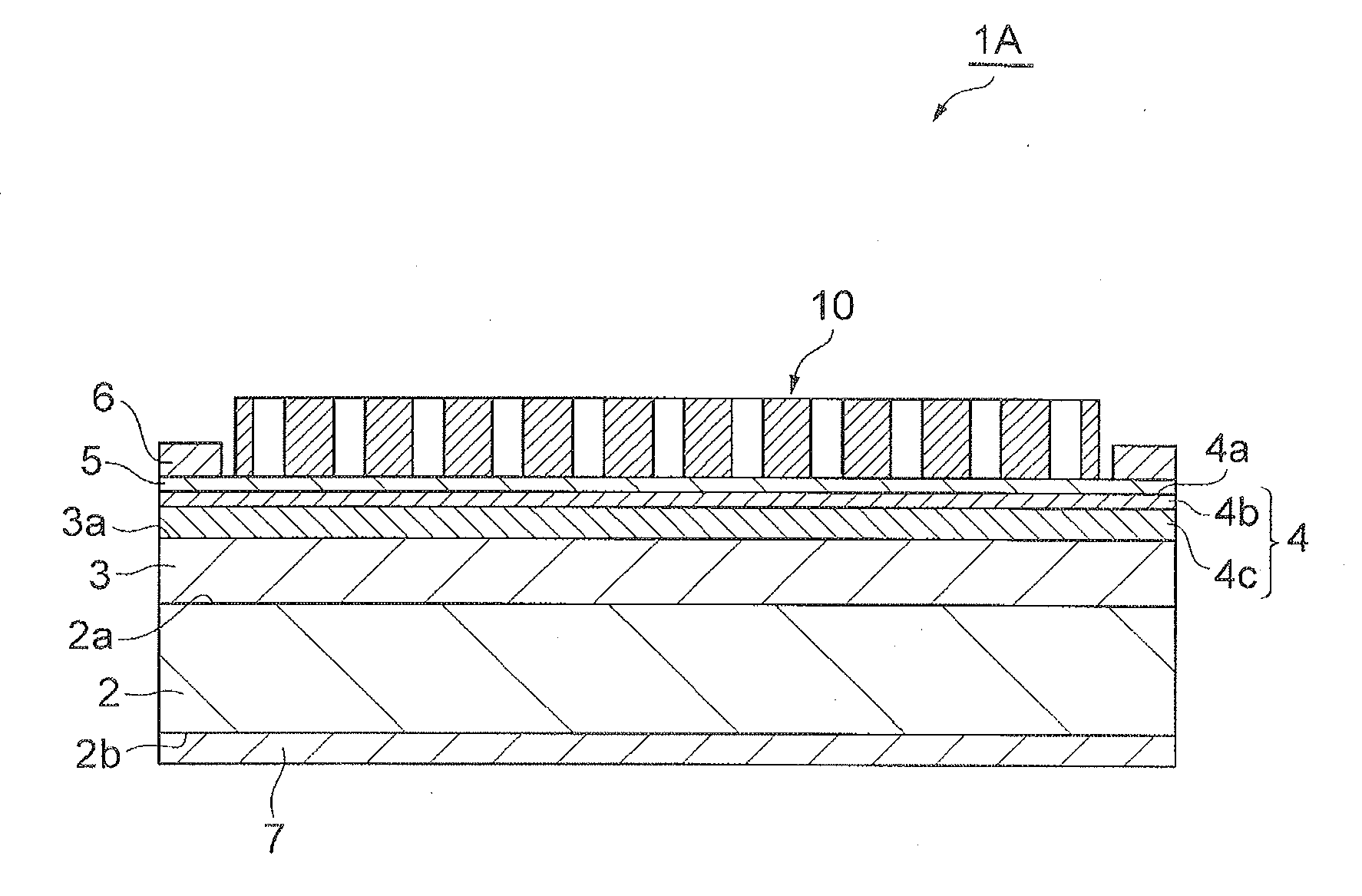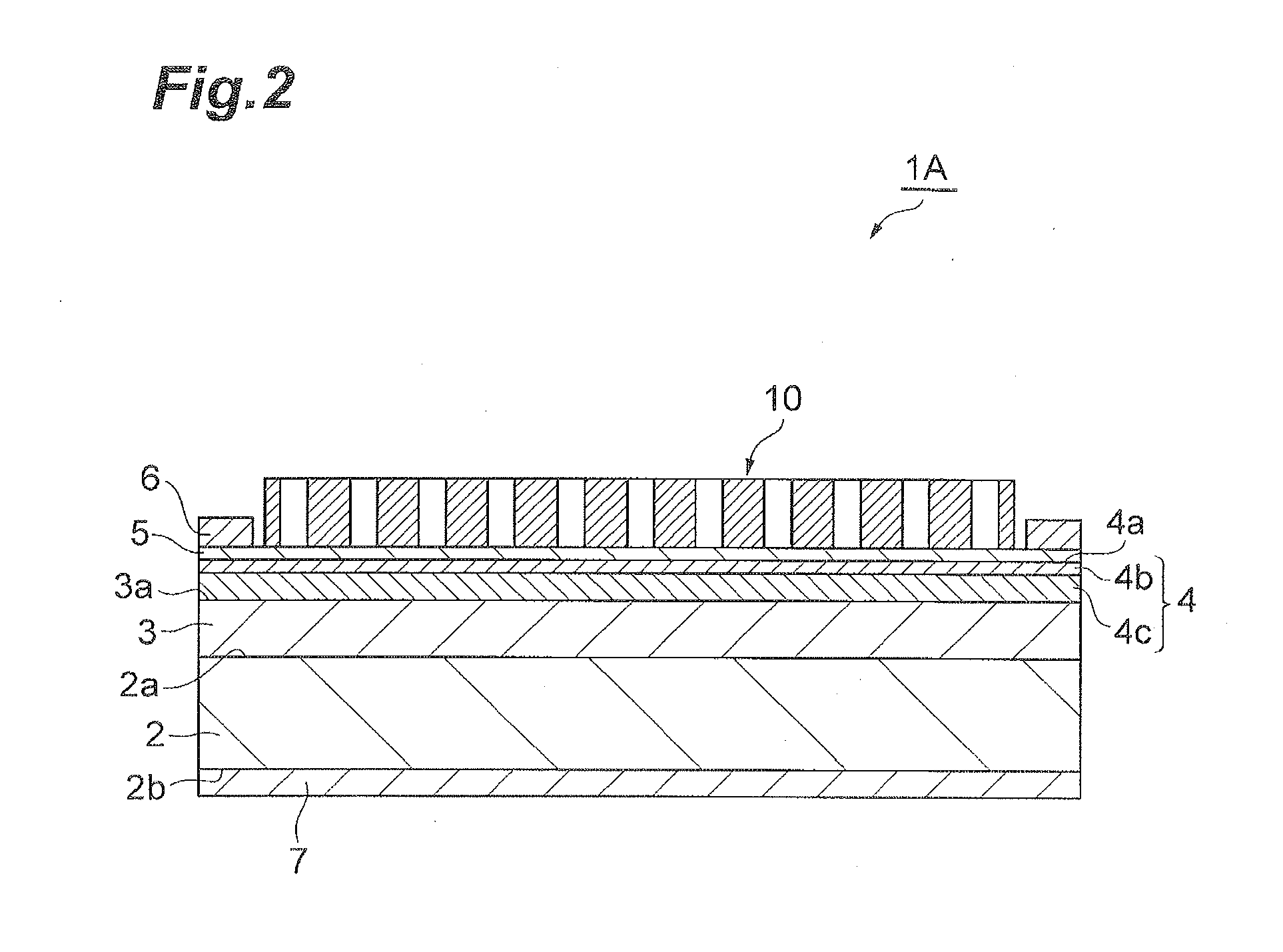Photodetector
a technology of photodetector and photoelectric field, which is applied in the direction of electrical apparatus, nanotechnology, semiconductor devices, etc., can solve the problems of cumbersome use of photodetector, and achieve the effect of widening the sensitive wavelength band
- Summary
- Abstract
- Description
- Claims
- Application Information
AI Technical Summary
Benefits of technology
Problems solved by technology
Method used
Image
Examples
first embodiment
[0049]As illustrated in FIGS. 1 and 2, a photodetector 1A comprises a rectangular plate-shaped substrate 2 made of n-type InP having a thickness of 300 to 500 μm and contact layers 3, 5, a semiconductor multilayer body 4, electrodes 6, 7, and an optical element 10 which are stacked thereon. This photodetector 1A is a photodetector which utilizes light absorption of quantum intersubband transitions in the semiconductor multilayer body 4.
[0050]The contact layer (second contact layer) 3 is disposed all over a surface 2a of the substrate 2. The semiconductor multilayer body 4 is disposed all over a surface 3a of the contact layer 3. The contact layer (first contact layer) 5 is disposed all over a surface 4a of the semiconductor multilayer body 4. At the center of a surface 5a of the contact layer 5, the optical element 10 having an area smaller than the whole area of the surface 5a is disposed. That is, the optical element 10 is arranged so as to be contained in the contact layer 5 when...
second embodiment
[0078]Another mode of the photodetector will now be explained as the second embodiment of the present invention. The photodetector 1B of the second embodiment illustrated in FIG. 8 differs from the photodetector 1A of the first embodiment in that it comprises, as an optical element, an optical element 20 made of a dielectric body having a large refractive index in place of the optical element 10 made of gold.
[0079]This optical element 20 is an optical element for transmitting therethrough light from one side to the other side in the predetermined direction, in which the first regions R1 are made of the dielectric body having a large refractive index. The difference between the refractive index of the first regions (dielectric body) R1 and that of the second regions (air) R2 is preferably at least 2, more preferably at least 3. For infrared light having a wavelength of 5 μm, for example, germanium and air have refractive indexes of 4.0 and 1.0, respectively. In this case, the refract...
third embodiment
[0083]Another mode of the photodetector will now be explained as the third embodiment of the present invention. The photodetector 1C of the third embodiment illustrated in FIG. 9 differs from the photodetector 1A of the first embodiment in that the contact layer 5 is disposed only directly under the electrode 6 instead of all over the surface 4a of the semiconductor multilayer body 4 and that the optical element is accordingly provided directly on the surface 4a of the semiconductor multilayer body 4. The optical element 20 of the second embodiment may be employed in place of the optical element 10. As can be seen from calculation results which will be explained later, the electric field component in a predetermined direction generated by light incident on the optical element from one side in the predetermined direction appears most strongly near the surface on the other side of the optical element. Therefore, the photodetector 1C of this embodiment, in which the optical element 10 ...
PUM
 Login to View More
Login to View More Abstract
Description
Claims
Application Information
 Login to View More
Login to View More - R&D
- Intellectual Property
- Life Sciences
- Materials
- Tech Scout
- Unparalleled Data Quality
- Higher Quality Content
- 60% Fewer Hallucinations
Browse by: Latest US Patents, China's latest patents, Technical Efficacy Thesaurus, Application Domain, Technology Topic, Popular Technical Reports.
© 2025 PatSnap. All rights reserved.Legal|Privacy policy|Modern Slavery Act Transparency Statement|Sitemap|About US| Contact US: help@patsnap.com



